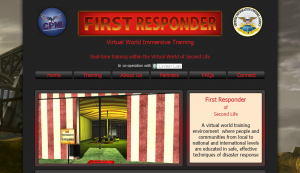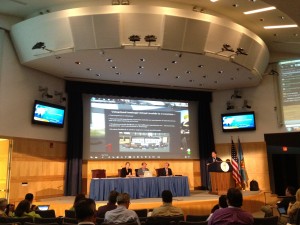Last week, I attended the Federal Consortium for Virtual Worlds annual conference. I realize the theme for the conference was “Inspire the Future,” but an underlying theme I sensed was “Keeping up with the Future.” Our society and the technological changes are hitting us at an exponential rate. Like one of the attendees said to me, imagine being Socrates teaching in Greece in the centuries before Christ. You would start out your class with an introduction to the two new discoveries that might have occurred that year. Today, there’s so much happening, no one can follow it all even in one field. But I still think the two themes complement each other. While many there were attending in order to learn and keep up, they are also the same people who will or have done things to inspire future work and changes.
One of the interesting aspects of being at this type of conference is that you get a sense you are watching these future developments occuring before your eyes. One of the sessions I attended on the Workshop day was FIRST RESPONDER: Virtual Platform Immersive Training Project. Because I am considered an emergency responder and have taken many classes in this area, it was definitely a workshop not to be missed. The session was led by Dr. Paula Smith, chief operating officer at the Catastrophic Planning and Management Institute. Dr. Smith shared with us the work they have accomplished in delivering emergency response training in an immersive environment. Because many in the audience are also working in this area and involved in collaborations on a global level, I believe important ideas were shared and the potential of future partnerships formed. The key points I took away from the session was that their work is based on recognized systems such as NIMS and ICS and they have increased learning retention rates by 29% to 39% using this technology and approach. You can learn more about their classes at their First Responder Virtual World Immersive Training Website.
Unity3D
One of the other two workshops I attended focused on developing online training using learning concepts of Robert M. Gagne. And the other was a three-hour introduction into the use of Unity3D. Unity3D was a hot topic throughout the conference so I expect to see even more learning environments developed with that platform in the future. And it seems there is some promise in the future of development tools being created for Unity3D that will make it even easier to build and link to existing data. As for the workshop, it was well attended, and the presenters – Eric Hackathorn and Julien Lynge – did such a great job the time flew by so fast. Eric and Julien, along with Eric’s father, Richard, are all awesome innovators who you definitely want to keep an eye on if you are looking for inspiration. You can check out their work through Fragile Earth Studios, a project of NOAA.
Online/Game Characters
Jesse Schell, a professor at Carnegie Mellon University and author of The Art of Game Design, led off the keynotes with a discussion of The Future of Virtual Characters. His insights and interesting presentation style pushed us to rethink the definition of avatars and how we are represented online. I enjoyed his pronouncement that “Mario is a terrible friend” because each time you play any of his games he acts as if it was the first time you have met. He seems to have totally forgotten all those adventures you shared saving princesses, winning races, or defeating monsters. Schell imagines a time when online characters will recognize you and remember your shared experiences. They will age with you and perhaps become one of your most trusted companions because they will listen and interact with us. Another interesting concept he shared was based on a book, The Innovator’s Dilemma by Clayton Christensen. The key point was that companies can fail or lose ground to newer, smaller companies because they let customers drive their innovation. He pointed out that customers who seem comfortable with a product might not realize the benefits of a newer product and might discourage a company from developing it. This leaves the door open for another company to bring the product forward and attract the customers away.
Virtuality
Randy Hinrichs, CEO of 2b3d, covered a history of how we got to where we are today with virtual technology and where we might be going. I liked his points about mentor networks and certification of online work so we can approach it with more trust. James Blascovich followed up with a presentation about the Mind, Brain, and Virtual Reality. His work explores how the mind processes real and virtual images and how the distinction does not really matter to our brains – both can be perceived as real. The day concluded with a panel discussing the future of health applications in virtual worlds. There’s been a lot of work done in this area. One of the interesting ideas proposed during the talk was that because games for health have been proven to be so beneficial, insurance companies may one day receive claims for patient game play.
The NTER Online Course Tool
The last day of the conference began with Dr. Michelle Fox of the Department of Energy sharing information about NTER. This is an online framework people can use to develop and deliver online training and education. There was a lot of good information presented about how the tool works and how people can use it to deliver courses. I just don’t think I can do it justice in a short synopsis so I would encourage you to view it yourself, along with all the other sessions, at the link I included at the end of this post. Even if you aren’t interested in developing courses, you might still want to check out their site because people have listed courses there for you to take. Right now there are classes covering blower doors, hazards, insulation, pumping, steam, building science, and many more topics.
MOSES
The next panel discussed their work on MOSES, an open simulator-based grid set up by Douglas Maxwell. Douglas is an engineer, staff researcher at the Naval Undersea Warfare Center, and huge innovator who has done amazing things over the years to showcase and develop the use of 3D immersive spaces by government. Dr. Kay McLennan is a professor who teaches economics and business practices at Tulane University. Kay has been a great friend to me and fellow virtual world explorer ever since we met a few years back on her sim in Second Life. Kay has always produced amazing high quality work in the 3D space and was one of the winners in the Federal Virtual Worlds Challenge. I was not as familiar with the work of the other two panelists, Robert Daniel, an adjunct professor at George Washington University, and Andrew Stricker, with the Air University. So it was interesting to learn more about the projects they have developed in MOSES.
Learning and Security
The final two sessions covered learning and security in virtual worlds. Dr. Reneta Lanisquot, with New York City College of Technology and one of the learning panelists, suggested we are at the “Pong” stage with virtual worlds. She also shared how adding a more “fun” element like Alice to a computer programming class significantly made a difference in learning and in future performance of students. In the security session, I really liked how Dr. Barbara Endicott-Popovsky with the University of Washington emphasized the need for people to consider the unintended consequences of technology. If we did this more across all disciplines we could save ourselves a lot of time and money and problems as a society.
Final Wrap Up
The conference ended with closing remarks from both Randy Hinrichs and Paulette Robinson. Of course, everyone in virtual worlds in government knows Paulette – she is a tireless innovator with the National Defense University (NDU) who has inspired and supported many of us to pursue and leverage 3D immersion within government. Without her and the backing and support of Dr. Robert Childs, the Chancellor of NDU, we would not be able to attend such a great conference. The other cool part of the end was that the National Highway Institute won the government project award for their work with delivering bridge training and a geotechnical conference through a virtual setting. And as a civil engineer, I look forward to continued use of 3D immersive tools within that agency.
I can’t complete a true summary of the conference though without mentioning all of the very incredible and inspiring people who I either met or reconnected with while there. And there were also the many more who participated online. There were just so many, I wish I could list them all, but don’t want to take the chance I might miss one. I look forward to continuing the conversation online as we continue to inspire, help each other keep up, and celebrate each other’s innovations.
If you want to listen to any of the main conference sessions yourself, they are availabe at http://www.livestream.com/ndustreampremium
And below is a stream of the tweets about the conference:






Great write-up of the event, Pam! Thank you.
Thanks for the kinds words Pam. 🙂 As always, it was great to see you.
That’s pretty awesome. Great write-up.
Thanks all of you for the kind words! Glad everyone enjoyed it and great to see you again Eric!
Sounds like a great experience, I had no idea this was out there. We could spend all our time reading, attending, researching and staying abreast of exciting stuff – when would we actually get work done?
I am so thankful for Govloop, so much information and POCs readily available – for us “information/innovation” junkies it is very cool.